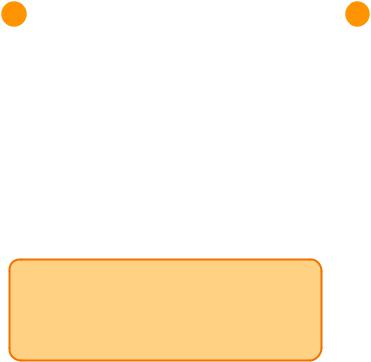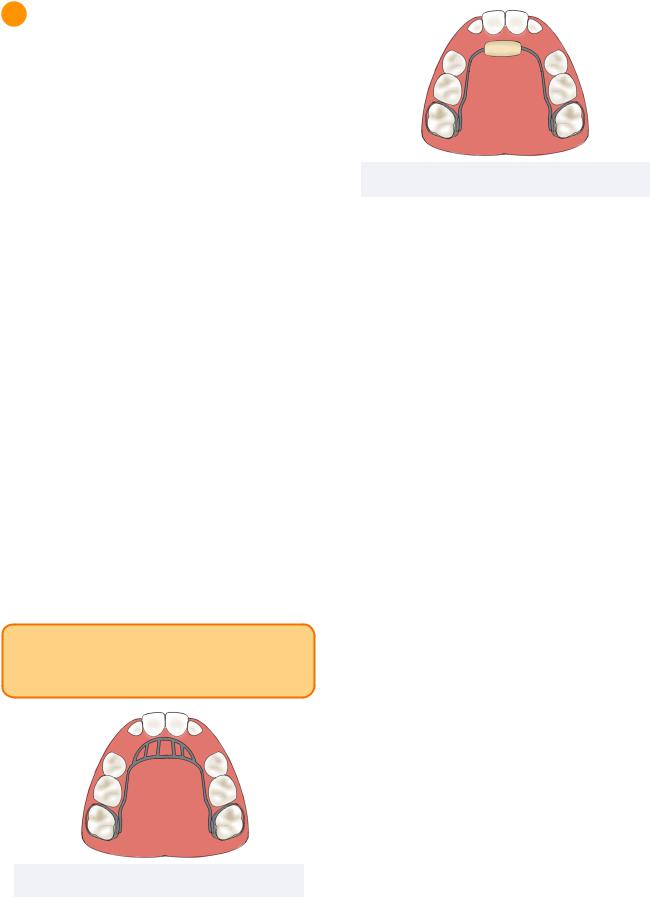
- •Bud Stage
- •Initiation
- •Cap Stage
- •Bell Stage
- •Apposition
- •Maturation
- •Summary
- •Primary Teeth
- •Permanent Teeth
- •2-3 Rule
- •Supernumerary Teeth
- •Congenitally Missing Teeth
- •Microdontia
- •Macrodontia
- •Fusion
- •Gemination
- •Taurodontism
- •Dens Evaginatus
- •Dens Invaginatus (Dens in Dente)
- •Dilaceration
- •Enamel Hypoplasia
- •Amelogenesis Imperfecta (AI)
- •Dentinogenesis Imperfecta (DI)
- •Regional Odontodysplasia
- •Concrescence
- •Enamel Pearl
- •Dentin Dysplasia
- •Primary Maxillary Central Incisor
- •Primary Maxillary Lateral Incisors
- •Primary Maxillary Canine
- •Primary Maxillary First Molar
- •Primary Maxillary Second Molar
- •Primary Mandibular Central Incisor
- •Primary Mandibular Lateral Incisor and Canine
- •Primary Mandibular Canine
- •Primary Mandibular First Molar
- •Primary Mandibular Second Molar
- •Prevention
- •Fluoride for Children
- •Amalgam Restorations
- •Composite Resin Restorations
- •Stainless Steel Crown
- •Strip Crown
- •Signs and Symptoms
- •Indirect Pulp Cap
- •Direct Pulp Cap
- •Pulpotomy
- •Pulpectomy
- •Extraction
- •Summary
- •Primate Space
- •Leeway Space
- •Interdental Space
- •Primary Incisor Loss
- •Primary Canine Loss
- •Primary First Molar Loss
- •Primary Second Molar Loss
- •Eruption Pattern Variations
- •Root Development
- •Rule of Seven
- •Space Closure
- •Ectopic Eruption of Incisors
- •Ectopic Eruption of Premolars
- •Ectopic Eruption of Molars
- •Colour
- •Contour
- •Consistency
- •Texture
- •Sulcus
- •Gingivitis
- •Acute Necrotizing Ulcerative Gingivitis
- •Reduced Attached Gingiva
- •Eruption Cyst
- •High Frenum
- •Periodontitis
- •Luxations - Intrusion, Extrusion, Lateral Luxation
- •Intrusion
- •Extrusion
- •Avulsion
- •Alveolar and Crown-Root Fracture
- •Concussion
- •Craze Lines and Enamel Fractures
- •Enamel and Dentin Fractures
- •Subluxation
- •Extensive Tooth Structure Involvement
- •Medical History
- •Prevention
- •Pediatric Behaviour Types
- •Frankl Rating Scale
- •Autism Spectrum
- •Anticipatory Guidance
- •Familiarization
- •Functional Inquiry
- •Pre-Visit Imagery
- •Knee-to-Knee Exam
- •Systematic Desensitization
- •Distraction
- •Picture Exchange Communication System (PECS)
- •Behaviour Shaping
- •Treatment Deferral
- •Protective Stabilization
- •Aversive Conditioning
- •Minimal Sedation - Anxiolysis
- •Moderate Sedation - Conscious Sedation
- •Deep Sedation - IV Sedation
- •General Anesthesia
- •Nitrous Sedation
- •Local Anesthesia

Pediatrics |
37 |
Child Behaviour and Management
1 Child Behaviour
Pediatric Behaviour Types
The major pediatric behaviour types are:
•cooperative
•avoidant
•defiant
•fearful or anxious
•uncontrolled
•tense-cooperative
•whining
Cooperative Patients
Cooperative patients are communicative, comprehending, and willing in the operative chair. They have minimal apprehension.
Potentially Cooperative Patients
These patients demonstrate appropriate behaviour but may be disruptive based on various factors during dental care. These patients are further subdivided into categories which may be dependent on age.
•Avoidant - avoiding operator
•Defiant (all ages) - spoiled, stubborn patients who dislike instruction
•Uncontrolled (3-6 years old) - may throw tantrums
•Timid (3-6 years old) - may demonstrate fear by hiding behind caregivers (shielding) or become uncontrolled when uncomfortable
•Tense-Cooperative (7+ years old) - patient attempts to cooperate but may be stiff, show white knuckles, and tense in fear
•Whining - continuous whining but usually no tears
Uncooperative or Uncontrolled Patients These patients may be uncommunicative, non-comprehending, and unwilling to demonstrate appropriate behaviour. These types of children are more commonly seen in infants, as well as certain groups of disabled children.
Frankl Rating Scale
The Frankl rating scale is based on a study published in 1962 which ranks child behaviour. Children generally increase in rank over time and with positive interactions.
Rank |
Description |
|
|
|
|
1 - Definitely |
Children which demonstrate |
|
refusal, forceful crying, and |
||
Negative |
||
unwillingness to cooperate. |
||
|
||
|
|
|
|
Children may demonstrate |
|
2 - Negative |
reluctance, generally |
|
Resistance |
uncooperative, but less |
|
|
pronounced pessimism. |
|
|
|
|
|
Children demonstrate some |
|
3 - Positive |
acceptance, cooperation, |
|
Acceptance |
and willingness to |
|
|
cooperate. |
|
|
|
|
4 - Definitely |
Children who are interested, |
|
cooperative, and |
||
Positive |
||
enthusiastic. |
||
|
||
|
|
INBDE Booster | Booster PrepTM

Pediatrics
4 Behaviour Disorders
Attention Deficit Hyperactivity Disorder (ADHD)
ADHD is an inattentive and hyperactive disorder that is more common in boys and most commonly diagnosed from ages 3 to 6.
Patients may be undergoing treatment with psychostimulant medications with side effects including nausea, xerostomia, hypertension.
INBDE Pro Tip: The most common medications for ADHD are methylphenidate (Ritalin), Atomoxetine (Straterra), Amphetamine (Adderall).
Autism Spectrum
Autism is a spectrum disorder arising from differential brain development that leads to differences in perception and socialization.
Although there are a wide range of symptoms, some common symptoms may include repetitive behaviour, or heightened sensitivity to light and sound.
38
3Domains of Pediatric Patient Management
Physical Domain
This includes physical restraints such as papoose boards, belts, and tape.
Pharmacological Domain
Anesthetics, sedatives, and nitrous oxides may be options for patient management. Mild behavioural issues may require nitrous oxide, while more severe issues may require IV sedation or general anesthesia.
Reward-Oriented Domain
This utilizes reinforcement to optimize cooperation.
Aversive Domain
This domain utilizes punishment as a management strategy. This is not recommended for timid or tense-cooperative patients.
Linguistic Domain
Linguistic domain rely on communication to increase patient willingness.
INBDE Booster | Booster PrepTM

Pediatrics
4 Management Strategies
**The following management strategies are provided in a general order from most to least conservative.
Anticipatory Guidance
Anticipatory guidance refers to providing counselling that is age appropriate and focused on prevention of disease. This may include anticipatory guidance on dental development, age-appropriate oral hygiene instruction, and diet counselling.
The first dental visit should take place after the
first tooth eruption or first birthday, depending on the earlier event.
Thumbsucking
This is a very common, normal habit that does not require intervention up to age 3. However, it may result in increased overjet, anterior open bite, maxillary constriction, or posterior crossbite if the habit is of high intensity, duration, and frequency.
Intervention with appliances is recommended if the habit continues to age 5 or 6, including cribs or bluegrass which act as reminder appliances in the anterior palate.
INBDE Pro Tip: Thumbsucking appliance therapy is only effective with patient compliance.
Figure 4.01 Crib Appliance
39
Figure 4.02 Bluegrass Appliance
Familiarization
This strategy is a dental visit without dental intervention, but rather introducing the setting and instruments to mitigate fear. It is best recommended for patients who are uncooperative, tense-cooperative, or timid.
Functional Inquiry
A functional inquiry refers to any form of questioning with the caregiver to provide information on the chief complaint and allow for estimation of behaviour in the dental setting.
Pre-Visit Imagery
This strategy involves providing positive visual cues around the dental office to increase positive association to dental care. It is indicated for any patient and may be implemented as a part of familiarization or as an intervention visit.
Sensory-Adapted Dental Environments Adaptations can be made to a dental clinic to reduce fear in patients with dental anxiety or autism. This may include a blanket or dimmed lighting.
Animal Assisted Therapy
Trained animals may be introduced in the dental setting to reduce anxiety. However, it must be avoided in patients with allergies to animals, lack of interest or fear of animals.
INBDE Booster | Booster PrepTM

Pediatrics
Knee-to-Knee Exam
This strategy is often implemented for infants below the age of 2. It refers to an examination in which the dentist and caregiver sit knee-to-knee with the patient’s head in the dentist lap. This allows the caregiver to aid in the process while providing emotional support.
INBDE Pro Tip: The knee-to-knee is exam is an important high yield fact.
Systematic Desensitization
This technique involves gradual and more frequent exposures to components of dental procedures to minimize anxiety. This is very helpful for patients with dental anxiety or people with autism.
Direct Observation
Direct observation may include watching a video about the procedure, or explaining the procedure as it is performed on a positive role model.
Tell-Show Do
This technique involves providing a verbal explanation, demonstration, and execution of the procedure at hand. It allows patients to become familiar with the tools which may be especially helpful for patients with behavioural disorders.
40
Distraction
This technique utilizes attempts to divert the patient’s attention from potentially fearful situations. This may include music, virtual reality eyeglasses, or other methods.
Picture Exchange Communication System (PECS)
This strategy utilizes picture cards to facilitate communication with visual representations. It is indicated for non communicative patients.
Behaviour Shaping
This refers to slowly working towards a goal by providing immediate and specific positive feedback specific to the desired behaviour.
For example, directing the patient to turn their head while providing reinforcement as they are convinced to continue turning.
Treatment Deferral
Treatments may be concluded early if patients demonstrate uncontrolled behaviour with nonurgent care. Deferral until cooperation can be achieved is contraindicated if there are signs of active infection, pain, or trauma.
For example, silver diamine fluoride or interim therapeutic restorations can be utilized to safely defer the treatment.
INBDE Booster | Booster PrepTM
